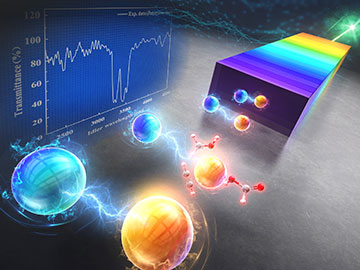Quantum infrared spectroscopy using ultra-broadband entangled photons. [Image: KyotoU/Shigeki Takeuchi]
Fourier transform infrared (FTIR) spectroscopy, the current state-of-the-art infrared (IR) spectroscopy technique, has widespread applications in chemistry, materials science, biology and other fields. However, efforts to miniaturize FTIR systems have been hindered by the relatively low efficiency of available IR sources and detectors.
Recently, quantum FTIR (QFTIR) spectroscopy has been demonstrated as a novel method that can perform FTIR spectroscopy using only visible light sources and detectors. Now, researchers at Kyoto University and Shimadzu Corporation in Japan have created an ultra-broadband QFTIR system (Optica, doi: 10.1364/OPTICA.504450). The new approach covers the wavelength range from 2.5 to 4.5 μm—more than double the bandwidth of previous techniques.
Leveraging entangled photons
Quantum IR spectroscopy uses pairs of entangled photons, one visible and one IR, to provide unique fingerprints of materials. By leveraging the quantum concept of “interaction-free measurements,” the technique can measure characteristic IR spectra for a given sample by detecting visible photons instead of infrared ones.
Because visible light sources and detectors are more compact and cost efficient than those in the IR region, going the quantum route is thought to hold promise for next-generation FTIR spectrometers. Up to this point, a significant barrier for quantum IR spectroscopy was the limited spectral coverage of less than 1 μm.
“A broad spectral bandwidth is essential for material differentiation,” said study author Shigeki Takeuchi, Kyoto University. “However, until now, the bandwidth of quantum entangled photons has been limited to a narrow range in the IR region, which has limited the bandwidth of quantum IR spectroscopy.”
Putting photon pairs to the test
The emission spectrum of a photon pair was continuously distributed in the wavelength range of 595 to 725 nm in the visible region and 2 to 5 μm in the infrared region.
Takeuchi and his colleagues developed a chirped quasi-phase-matching device to generate broadband two-photon states by varying the phase-matching condition. The emission spectrum of a photon pair was continuously distributed in the wavelength range of 595 to 725 nm in the visible region and 2 to 5 μm in the infrared region.
The experimental setup also included a continuous-wave laser with a wavelength of 532.45 nm as the pump source, along with a silicon avalanche photodetector for visible light detection. They constructed a nonlinear quantum interferometer using the entangled photons and performed ultra-broadband QFTIR spectroscopy over the range of 2.5 to 4.5 μm for a variety of inorganic and organic samples.
The researchers hope that their work will help advance quantum IR spectroscopy—particularly highly sensitive, ultra-portable systems—and beyond. "Improving the sensitivity of quantum infrared spectroscopy and developing quantum imaging in the infrared region are part of our quest to develop real-world quantum technologies," said Takeuchi.

